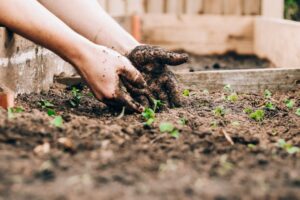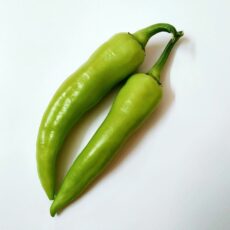Chilli pepper plants produce yummy, spicy fruits that can be used in all kinds of delicious recipes. 
That is, however, only if you get chilli plant care right and grow healthy, strong plants that produce fruit.
Unfortunately, many mistakes can scupper even the most dedicated gardeners’ chilli growing plans.
From diseases, to pest damage, stunted growth and more, there are many issues people run into when growing chilli plants.
To help you produce delicious chilli fruits on healthy, happy plants, here are 7 huge mistakes to avoid when growing chillies:
1. Using Compost With The Wrong Amount Of Nutrients
Good chilli plant care involves growing your chillies in a good-quality compost once you pot them up, as shown in this video.
However, a common mistake is assuming that compost contains everything your chilli plant needs to thrive. If your plant is growing well, the chances are it does have everything it needs to thrive.
If you’re seeing any issues with the plant, it could be the soil. Here are some common signs the compost needs adjusting:
- Low Potassium – any new leaves come through with yellow edges
- Low Manganese – older leaves show yellow spots and holes (potentially in newer growth as well)
- Low Nitrogen – older leaves start yellowing and the yellow spreads up the plant eventually
- Low Iron – yellow patches start showing between the veins of the leaf
- Low Calcium – new leaves have a crinkled look
- Low Phosphorus – Older leaves go really dark, or even purple and the damage spreads up the plant
- Low Magnesium – yellowing older leaves starting from the tips and moving inwards
Once you have identified the deficiency (and ensured the problem is not a pest or disease) you can add nutrients to the soil accordingly.
2. Reacting Rather Than Preventing
There is a lot of chilli plant care advice that works on the idea of reacting, rather than preventing common issues. This is a mistake, as often prevention is better than cure. Lots of simple precautions taken when growing chillies prevents a multitude of issues.
Here are some preventative tips to follow when growing chillies:
- Keep plants with plenty of space between them (two foot if grown in a bed) or one to a pot so that there is lots of airflow between plants
- Always ensure plants dry between watering
- Ensure your watering regime is regular, so plants don’t get stressed
- Water plants in the morning or evening to avoid leaf burn
- Keep your plants growing in a stable temperature
- Trim your plants to encourage plenty of airflow & good fruit growth
3. Assuming The Plants Will Be Pollinated
If you grow your plants outdoors, the pollination aspect of your chilli plant care is usually minimal. Hopefully pollinating insects will do their job and ensure you get plenty of chillies growing.
However, if your plants grow inside or pollination is an issue, you will have to lend a helping hand. You can do this by gently tapping the flowers everyday, or using a paintbrush or makeup brush to spread the pollen from flower to flower, just like a bee would.
4. Over Fertilising
With chilli plant care, over fertilising is a common issue. Gardeners can get a bit overzealous with the fertiliser, which then damages the plant. When you’re growing chillies, you actually need to only fertilise your chilli pepper plants twice.
Once when you apply the compost for them to grow after moving juvenile plants into their permanent growing position. If the compost is full of the right nutrients, you only then have to apply fertiliser again when the plants have started to form peppers.
5. Shallow Watering
Gardeners can water a little everyday, leaving the soil moist and the plant never getting a proper drenching, which can lead to plant disease, stress and stunted growth.
For the best chilli plant care you have to water deeply, regularly and when the soil has dried out to the first two inches of your finger.
6. Lack Of Drainage
If the water cannot drain out of your pepper plants well enough you may get root rot, which will eventually kill the plant. Any salts and unwanted nutrients may also not be able to rinse out of the plant, which could also be a problem.
To avoid this and maintain good chilli plant care you simply need to ensure that water can rinse through the soil well by adding some horticultural grit to the compost, ensuring the drainage hole is blocked and making sure the trays they sit in are regularly emptied.
7. Ignoring Pest Issues Before It Is Too Late
If your chilli plant care seems to be going well everyday, you may not necessarily do a deeper check of your plants until you see a reason to act. Unfortunately, by the time there are signs of pest issues it can be too late.
If you can, use a magnifying glass or a loupe to spot check your growing chillies and the plants they are on once a week. Check for eggs, living animals, webbing and dirt. If you are unfamiliar with the kind of pests seen most commonly on chilli plants, you can learn more about them in this handy article.
Spotting these pests early means you can treat your plants with safe pesticides before they take hold and scupper your chilli plant care.
“To forget how to dig the earth and tend to the soil is to forget ourselves.” – Mahatma Gandhi
The 7 common mistakes with chilli plant care above can be easily avoided with some quick adjustments to your chilli plant care regime and habits.
With the right adjustments, you’ll be growing chillies well this season, for delicious, spicy fruits to use in all kinds of wonderful recipes in your home kitchen.


